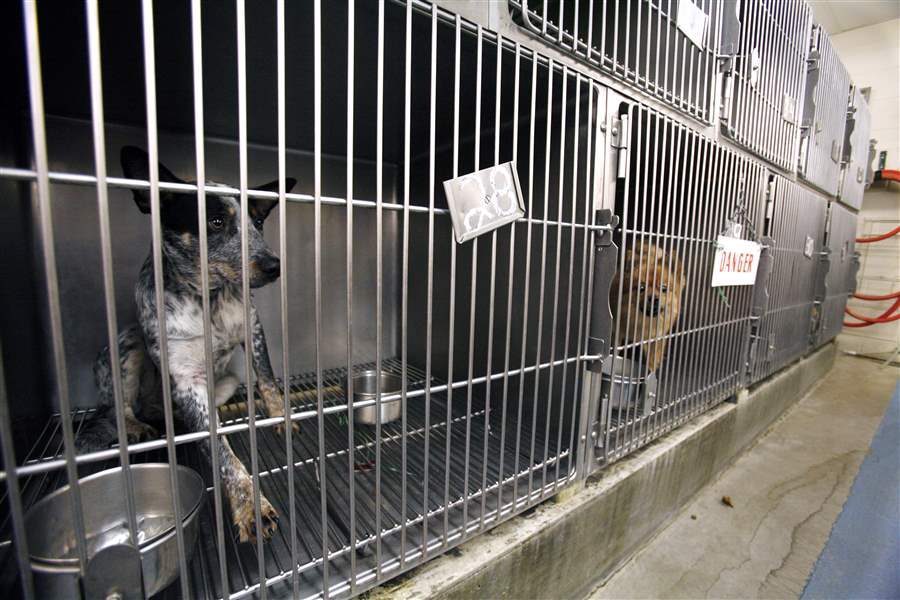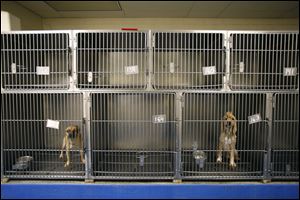
County leaders: Dog warden status quo is not acceptable
11/10/2009
Dogs can stay 3 to 14 days at the warden's office. Sometimes they stay longer because of weekends or holidays.
The Blade/Andy Morrison
Buy This Image

Lucas County Dog Warden Tom Skeldon pledges to ‘redouble' efforts to get dogs adopted, but he does not know ‘how there will be a whole lot different done beyond what we already do.'
Outspoken Lucas County Dog Warden Tom Skeldon yesterday vowed to “redouble” his efforts to boost adoptions of his shelter's four-legged visitors, even though he cited few specifics and said there's little more he can do to match good dogs with would-be owners.
Upon learning what Mr. Skeldon said late yesterday afternoon, Lucas County Commission President Pete Gerken said he will convene a face-to-face meeting with him this morning “to make sure he knows what he needs to do.”
“If he needs some creative thinking, I'll be happy to give some,” Mr. Gerken said.
Fundamentally, the county board president and other county officials said they want assurances that Mr. Skeldon knows the status quo won't cut it. They put together an ad hoc committee to review his operations earlier this year in part because they expect less euthanasia and more adoptions in the future.
“We really want to get some advice that would allow us to achieve that objective. I think the county commissioners have made it very clear and that Tom understands we are looking for change in this area,” county Administrator Mike Beazley said.
According to Commissioner Ben Konop, Mr. Skeldon agreed last November to get the shelter's adoption rate up to 24 percent by the end of this year and to 34 percent by the end of 2010.

Dogs can stay 3 to 14 days at the warden's office. Sometimes they stay longer because of weekends or holidays.
Figures in a four-page memo that Mr. Beazley presented to commissioners on Tuesday listed last year's adoption rate at 13 percent and showed 16.1 percent of the shelter's dogs being placed in new homes as of Aug. 22.
“All I can say is Mr. Skeldon stood with us and agreed to these goals and as far as I can tell, these goals aren't being met,” Mr. Konop said. “I reject his conclusion that he's done everything he can.”
Commissioner Tina Skeldon Wozniak, Mr. Skeldon's first cousin, said the 11-member dog warden advisory committee was empaneled to “help us find a way for every dog that is adoptable to find a new home.”
“We are intensely focused on this goal,” she said. “We will make it happen.”
But why isn't that happening now? Or is it?
Mr. Skeldon said yesterday that it has been his policy since taking office in 1987 to find new homes for all dogs that are good candidates for adoption.
That is, sweet and healthy ones with mild-mannered dispositions.
“We're going to try to do everything possible to make sure every good adoptable dog is adopted,” Mr. Skeldon said. “We will redouble those efforts. I can't really say how there will be a whole lot different done beyond what we already do. We've been doing that [trying to place as many adoptable dogs as possible in good homes] all along.”

Plenty of cages were vacant yesterday during a tour of the Lucas County dog shelter, which is on South Erie Street. Officials said overcrowding at the shelter tends to be a seasonal problem.
Mr. Skeldon said he is allowed by Ohio law to euthanize strays and dogs without licenses after three days of holding them at the shelter. Licensed dogs must be kept a minimum of 14 days. He said he intends to follow the law.
The reality is that dogs sometimes spend from one to three weeks at the pound before they are euthanized because Mr. Skeldon has instructed shelter employees not to count the day each dog is brought in, nor weekends or holidays.
If space is available, dogs deemed eligible for adoption may be kept longer before they are euthanized, Mr. Skeldon said.
“If you're going to hold dogs and not euthanize dogs, you would probably have to be in a continual state of construction. You have to just keep building and building and building more and more rooms,” he said. “The state law gives us guidelines as to the number of days dogs have to be held. We go beyond state guidelines.”
Now a controversial figure nationally for efforts he has undertaken to protect people in Toledo and other North American cities from vicious dogs, Mr. Skeldon blamed careless owners of pit bulls for inflating the euthanasia rate at the county's dog shelter on Erie Street.
The shelter is on the outskirts of downtown Toledo, across from the Erie Street Market.
Some advisory committee members recently claimed the euthanasia rate at his shelter is among the highest in Ohio at about 80 percent.
Mr. Skeldon said they erred in their calculations and that “it has always been in the 60s,” making it typical for cities that share Toledo's size and demographics.
A four-page memo submitted to Lucas County commissioners on Tuesday documented the county's euthanasia rate for dogs at 65.8 percent in 2008. It claimed 61.8 percent of the shelter's dogs this year had been euthanized as of Oct. 23.
“We are a success story. We are to be emulated,” Mr. Skeldon said. “We're being taken to task for doing our job.”
And what does he think his job is? Protect the public from vicious dogs.

The incinerator at the dog warden's office is used to dispose of euthanized dogs. The county's euthanasia rate for dogs was 65.8 percent in 2008, according to a memo submitted to county officials.
Prior to his arrival at the shelter yesterday, Mr. Skeldon gave permission to the shelter's new manager, Bonnie Mitchell, to give a tour of the facility.
Plenty of vacant cages were seen. Both Ms. Mitchell and Mr. Skeldon said any overcrowding they get tends to be a seasonal phenomenon.
Mr. Skeldon said the euthanasia rate is what it is in Lucas County because of a criminal element in society that has bred pit bulls for dogfighting and the gambling associated with it, as well as for drug dealers who use them for protection or intimidation.
“What's fueling this is drug money. It doesn't mean that everybody who's into pits is into drugs or anything like that,” he said.
But residents of some of Toledo's roughest neighborhoods know they can keep a female pit bull in their basement and breed her, with her puppies selling for $250 to $500.
“It's all under the table and no taxes. It's strictly an underground economy,” he said.
Pit bulls are the only dogs identified by name in the Ohio Revised Code as vicious animals.
County records show 910 pit bulls have been picked up from Toledo streets in 2009 — a figure down slightly from recent years.
Mr. Skeldon said he was not sure exactly how many of those were among the 1,621 dogs his office has euthanized so far this year, but he said he suspects the vast majority of them were.
Most of the others were drop-offs from people who said they wanted their dog euthanized because they were too old or having health or disciplinary problems, according to Mr. Skeldon.
“It's going to be very, very difficult for us to appreciably increase adoptions unless you adopt out pit bulls,” he said. “The driving impetus behind this problem is we're killing too many pit bulls. Frankly, the county isn't willing to accept the liability of those dogs. My job is to protect the public and their property from [vicious] dogs.”
Unlike many public officials who see more money and better facilities as their panacea, Mr. Skeldon wants neither.
He said the shelter is operating just fine at its current location on South Erie Street and doesn't need to be expanded. Nor does he need a sizable budget increase or more staffing.
When asked what he needs, he replied with a single word:
“Time,” he said. “We've turned the corner on the pit bull thing. The total number for dogs [euthanized] in Toledo has gone down,” Mr. Skeldon said.
So what will come of recommendations made by the advisory committee and endorsed by the county commission if Mr. Skeldon remains in charge?
Many will be implemented. But some, such as a new policy requiring vaccinations for all incoming dogs upon admittance, are subject to negotiation, Mr. Skeldon said.
He told The Blade he might have some misgivings about vaccinating some dogs, especially before they become the county's property, because of the potential for liability issues if those dogs develop adverse, life-threatening reactions.
The county doesn't legally take possession of the dogs until they have passed the three-day or 14-day mark, depending on their licensing status.

A boxer-mix pup waits outside its kennel while it is cleaned at the dog warden's office.
Dr. Debbie Johnson, the Toledo Area Humane Society's chief veterinarian and a member of the advisory committee, said the risk is minimal and is far outweighed by the benefits.
“If that was the case, we would run the risk of that in veterinary practice every day,” she said.
The committee wants all dogs to get rabies, distemper, and bordetella vaccines (the latter for the condition known as kennel cough). The rabies vaccines have a dead virus in it, while the distemper and bordetella vaccines have modified live viruses, Dr. Johnson said.
She said it has become standard operating procedure at shelters nationwide to vaccinate dogs upon intake.
“There's no need to reinvent the wheel,” she said.
The county dog warden's office has given outside experts a cool reception whenever this and other issues are brought up, Dr. Johnson said.
“We would love to consult and help them, but it doesn't seem it's welcomed when we offer it,” she said.
Though the dog warden falls under the county's jurisdiction, the final two Toledoans vying for the city's mayoral job on Tuesday weighed in with some thoughts on the matter.
“I have said before that whether, through a change in policy or a change in personnel or both, the operation of the dog warden's office must become more humane. The current low rate of adoption is unacceptable, and all efforts should be made to place more dogs in good homes,” Democrat Keith Wilkowski said. “If the dog warden fails to immediately take steps to increase the adoption rate, the commissioners should find someone who will.”
Former fire chief and former state fire marshal Mike Bell, who is running for mayor as an independent, said he would “definitely be telling him that we are going to follow the recommendations of the oversight committee” if he were a county commissioner.
Mr. Bell said he'd give him a deadline to comply — or else.
“Anybody that's working for the government is a public servant. We have to listen to the people,” Mr. Bell said.
Contact Tom Henry at:thenry@theblade.comor 419-724-6079.